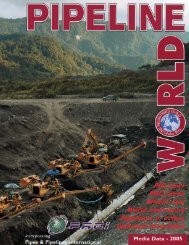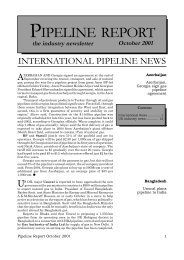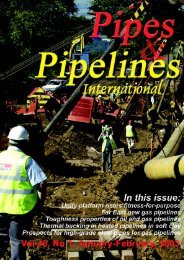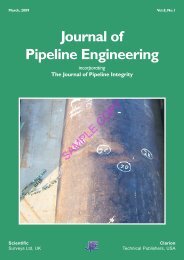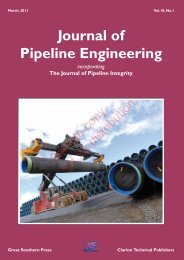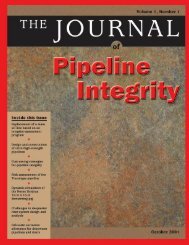JPE - Sept09 - cover2-4.pmd - Pipes & Pipelines International ...
JPE - Sept09 - cover2-4.pmd - Pipes & Pipelines International ...
JPE - Sept09 - cover2-4.pmd - Pipes & Pipelines International ...
Create successful ePaper yourself
Turn your PDF publications into a flip-book with our unique Google optimized e-Paper software.
192<br />
The Journal of Pipeline Engineering<br />
Fig.1. The CEL FE ice-gouge model. Fig.2. Simplified CEL FE ice-gouge model.<br />
Fig.3. CEL FE model vs centrifuge data.<br />
validation, sensitivity and hypothetical design studies that<br />
have demonstrated the reliability and applicability of the<br />
tool.<br />
Ice-gouge model validation<br />
Modelling of the ice-gouge phenomenon has been<br />
approached through small- and medium-scale experimental<br />
testing, analytical and empirical formulations, simplified<br />
structural analyses, and advanced numerical techniques.<br />
However, uncertainty remains on the magnitude and extent<br />
of subgouge soil deformations, giving rise to uncertainty in<br />
pipeline burial depth requirements.<br />
The results obtained using the model were compared with<br />
existing experimental centrifuge data. In order to match<br />
the centrifuge testing conditions, the trench geometry,<br />
trench backfill material, and the pipeline were removed<br />
from the model, as shown in Fig.2.<br />
Sample issue<br />
The centreline horizontal subgouge displacement profile<br />
resulting from a simulation with clay soil compared to<br />
centrifuge data is shown in Fig.3. The gouge depth and<br />
width were 1.2m and 10m, respectively. The accuracy at<br />
one gouge depth is approximately 85% with good correlation<br />
extending downward.<br />
Ice-gouge model application<br />
Using the developed model, a hypothetical study was<br />
carried out assuming a 305-mm (12-in) diameter pipeline<br />
with varying wall thicknesses. The pipe was placed in a 3.61m<br />
deep trench, 1m wide at the bottom and with side slopes<br />
2V:3H. The burial depth was 3m measured from the top of<br />
the pipe. The trench soil was modelled using a softer<br />
material relative to the surrounding native seabed. The<br />
model was run a number of times for a range of D/t values<br />
and depths.



